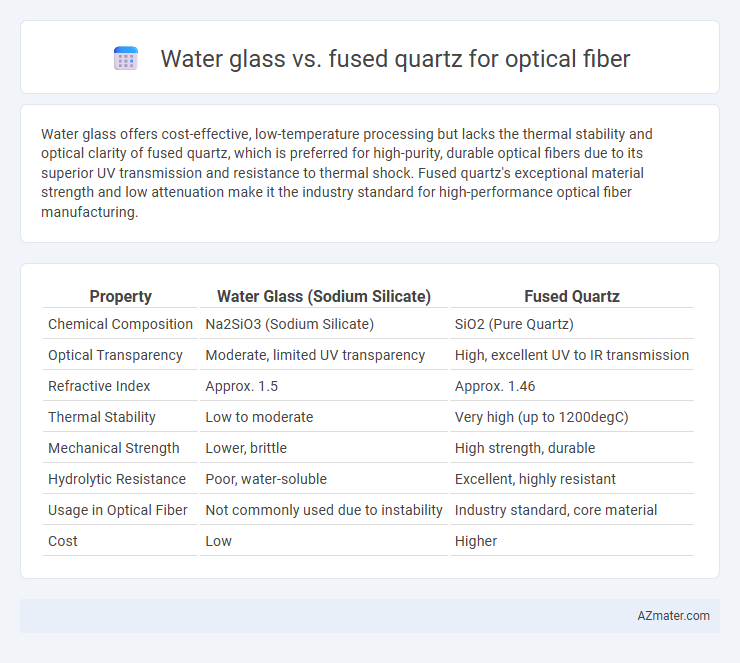Water glass offers cost-effective, low-temperature processing but lacks the thermal stability and optical clarity of fused quartz, which is preferred for high-purity, durable optical fibers due to its superior UV transmission and resistance to thermal shock. Fused quartz's exceptional material strength and low attenuation make it the industry standard for high-performance optical fiber manufacturing.
Table of Comparison
| Property | Water Glass (Sodium Silicate) | Fused Quartz |
|---|---|---|
| Chemical Composition | Na2SiO3 (Sodium Silicate) | SiO2 (Pure Quartz) |
| Optical Transparency | Moderate, limited UV transparency | High, excellent UV to IR transmission |
| Refractive Index | Approx. 1.5 | Approx. 1.46 |
| Thermal Stability | Low to moderate | Very high (up to 1200degC) |
| Mechanical Strength | Lower, brittle | High strength, durable |
| Hydrolytic Resistance | Poor, water-soluble | Excellent, highly resistant |
| Usage in Optical Fiber | Not commonly used due to instability | Industry standard, core material |
| Cost | Low | Higher |
Introduction to Optical Fiber Materials
Water glass, primarily composed of sodium silicate, offers a cost-effective but less durable material option for optical fiber cladding and coatings due to its lower thermal stability and higher optical loss. Fused quartz, composed of high-purity silicon dioxide, provides superior optical transparency, low attenuation, and excellent thermal and chemical resistance, making it the preferred material for core and cladding in high-performance optical fibers. The selection of optical fiber materials significantly impacts signal transmission quality, mechanical strength, and environmental resistance, with fused quartz widely recognized for optimizing the efficiency and reliability of modern fiber optic communication systems.
Composition of Water Glass vs Fused Quartz
Water glass, primarily composed of sodium silicate (Na2SiO3), contains a significant amount of sodium oxide and silica, resulting in a less pure silica matrix compared to fused quartz. Fused quartz consists almost entirely of pure silicon dioxide (SiO2) with minimal impurities, providing superior thermal stability, optical clarity, and resistance to radiation, which are critical for optical fiber performance. The presence of alkali metals in water glass can lead to increased optical attenuation and reduced durability, making fused quartz the preferred material for high-quality optical fiber manufacturing.
Optical Transparency and Light Transmission
Water glass, or sodium silicate, offers moderate optical transparency with some scattering and absorption losses, limiting its efficiency in light transmission for optical fiber applications. Fused quartz, composed of high-purity silicon dioxide, exhibits exceptional optical transparency across a wide wavelength range, minimizing attenuation and enhancing light transmission performance. The superior UV and IR transmission properties of fused quartz make it the preferred material for high-performance optical fibers.
Mechanical Strength and Durability
Fused quartz exhibits significantly higher mechanical strength and durability compared to water glass, making it the preferred material for optical fiber manufacturing. Its superior resistance to thermal shock and chemical corrosion ensures long-term structural integrity under harsh operating conditions. Water glass, while easier to process, lacks the robustness required for high-performance optical fibers, limiting its practical applications in demanding environments.
Thermal Stability and Resistance
Fused quartz exhibits superior thermal stability compared to water glass, withstanding temperatures above 1000degC without significant deformation, making it ideal for high-temperature optical fiber applications. Water glass, primarily an alkali silicate solution, has limited thermal resistance and can degrade or lose structural integrity at elevated temperatures. The exceptional thermal resistance and low thermal expansion of fused quartz ensure consistent optical performance and durability in fiber optic environments subjected to thermal stress.
Impurity Levels and Purity Considerations
Fused quartz exhibits significantly lower impurity levels compared to water glass, making it the preferred material for high-purity optical fiber fabrication. The exceptional purity of fused quartz, often exceeding 99.99% SiO2, minimizes optical attenuation and enhances signal transmission quality. In contrast, water glass contains higher concentrations of metallic and hydroxyl impurities, which increase optical loss and reduce fiber performance in telecommunications.
Manufacturing Processes and Scalability
Water glass manufacturing involves a sol-gel process that enables lower temperature production and cost-effective scaling but may introduce impurities affecting optical clarity. Fused quartz is typically produced via high-temperature flame fusion or electric melting, resulting in superior purity and homogeneity essential for high-performance optical fibers yet demands significant energy and extended production time. Scalability favors water glass for mass production with moderate optical requirements, while fused quartz remains preferred for premium fibers requiring exceptional mechanical strength and minimal signal loss.
Cost-Effectiveness and Availability
Water glass offers a lower-cost alternative for optical fiber production but often compromises durability and transmission quality compared to fused quartz. Fused quartz provides superior purity and thermal stability, ensuring higher performance and longer lifespan, though its higher cost and limited availability can restrict large-scale manufacturing. Evaluating cost-effectiveness requires balancing initial material expense against long-term reliability and application demands.
Applications in Modern Optical Fiber Technology
Water glass, primarily composed of sodium silicate, serves as a cost-effective cladding material in some optical fiber applications but lacks the thermal stability and low optical loss characteristics required for high-performance modern optical fibers. Fused quartz, made from high-purity silica, offers superior optical clarity, excellent thermal resistance, and minimal signal attenuation, making it the preferred material for core and cladding in advanced telecommunication and high-speed data transmission fibers. The enhanced chemical purity and mechanical strength of fused quartz enable its critical role in high-bandwidth, long-distance optical fiber networks and specialized sensing applications.
Conclusion: Choosing the Optimal Material
Fused quartz offers superior optical clarity, higher thermal stability, and greater resistance to chemical corrosion compared to water glass, making it the preferred material for high-performance optical fibers. Water glass, while more cost-effective and easier to process, typically exhibits lower durability and increased attenuation, limiting its application in precision fiber optics. Selecting fused quartz ensures enhanced signal transmission quality and longevity, critical for demanding optical fiber technologies.

Infographic: Water glass vs Fused quartz for Optical fiber
 azmater.com
azmater.com